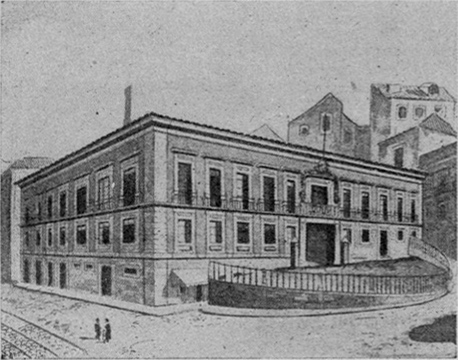Chronological span
The judicial reform promulgated by King Filipe I in 1582 established this court in Lisbon, putting an end to the hitherto itinerant character of this institution1Ed. Regimento da Casa da Suplicaçam, 1583..
As part of the liberal reforms of the kingdom’s administration, Mouzinho de Silveira called for its abolition in 18322Ed. Colecção de Decretos, 1st series, 1834, p. 90-138, specifically p. 133-134., which was put into effect by a decree of the following year3With the appointment of its judges by Decree of 30 July 1833, ed. Chronica Constitucional de Lisboa, 1833, nº 7, p. 25..
Normative documents (main)
Competences
General
After 1582, the Casa da Suplicação began to receive and settle civil and criminal appeals and grievances from the centre and south of the kingdom (the districts of Estremadura, Entre Tejo and Odiana, and Algarve), the Islands, and some private courts11 Testos, 2018a, p. 108., namely in civil suits and those involving orphans judged by the municipal judges of Lisbon12OF, bk. 1, tit. 6, §12. Testos, 2018a, p. 119. To speed up the appeals, the grievances coming from the municipal judges, the ouvidor of Lisbon or any other judge of this city would go directly to the Casa da Suplicação, that is, without having previously passed through the Court’s corregedores or the city’s orphans’ provedor (Hespanha, 2015, §231).. In the case of grievances from the Relação da Casa do Porto, the Ordenações Filipinas established that the referred appeals could only be received by the Casa da Suplicação when they exceeded the value of one hundred thousand réis in the case of movable assets and eighty thousand réis in the case of immovable property13OF, bk. 1, tit. 6, prologue and tit. 37, §2..
On entails
The Casa da Suplicação, established in Lisbon after 1582, took over from the abolished Casa do Cível the appeals against sentences pronounced by the Provedores of the chantries and residuary estates of Lisbon14Ed. Regimento da Casa da Suplicaçam, 1583, prologue; OF, bk. 1, tit. 6, §2.. This institution intervened in cases relating to the chantries and morgadios belonging to the Crown through a private court, institutionalised at the beginning of the seventeenth century, which was attached to the magistracy of the Juiz dos Feitos da Coroa e Fazenda (see heading “Juízo das Capelas da Coroa”)15This dependence is expressly mentioned in a warrant of 13 July 1660, by which the king authorises Judge Manuel Gameiro de Barros to accumulate the two magistracies “in the same way as the other judges before him have done” (Silva, Collecção Chronologica, 1854-1859, vol. 8, p. 40)..
Institutional organisation and the roles of its agents with regard to entails
Institutional organisation
See heading Casa da Suplicação (1440s-1582), subheading “Institutional organisation and the roles of its agents—Institutional organisation”.
The roles of its agents
Desembargadores do Paço e Petições (and of the Agravos)
See heading Casa da Suplicação (1440s-1582), subheading “Institutional organisation and the roles of its agents—Institutional organisation”.
These magistrates were authorised to receive appeals and grievances from the Provedores of the Residuary Estates and chantries of the district when their value exceeded ten thousand réis22Ed. Regimento da Casa da Suplicaçam, 1583, prologue..
Juiz dos Feitos da Coroa e Fazenda
This official heard appeals from all judicial proceedings related to crown assets and rights23OF, bk. 1, tit. 9, prologue.. The Ordenações Filipinas specifically refer to the case of appeals against sentences relating to royal jurisdictions and rights that were the object of donation or that were returned to the Crown24OF, bk. 1, tit. 9, §2 e 6.. His involvement in these matters justified the fact that to this magistracy was attached that of Juiz das Capelas da Coroa (see previous heading), being in this last capacity (and much more rarely in his capacity as Juiz dos Feitos da Coroa e Fazenda) that he intervened in judicial actions regarding chantries and morgados belonging to the Crown.
Procurador dos Feitos da Coroa
According to the Ordenações Filipinas, it was the responsibility of the Procurador dos Feitos da Coroa to obtain information from the remaining officers of the Crown on the royal rights relating to the cases pending before the Juízes dos Feitos da Coroa25OF, bk. 1, tit. 12 prologue, in which the officers who could be subject to this enquiry are listed (Desembargadores do Paço, Vedores da Fazenda, Contadores, Juízes, Almoxarifes and any other officials).. In this context, and for the defence of the king’s jurisdiction, property, and rights, this official could intervene as he wished in those cases pending before the respective judge, as well as be present during the decision-making of the magistrates in all proceedings in which he was involved as plaintiff, defendant, opponent, or assistant26OF, bk. 1, tit. 12, prologue -§2.. Likewise, he could litigate in the cases of which he had knowledge (sight) in the Relações (High Courts)27OF, bk. 1, tit. 12, prologue -§1.. In line with these prerogatives, this official played an important role in litigating, before the Juiz das Capelas da Coroa, cases relating to the chantries and morgadios belonging to the king, representing the monarch as one of the concerned parties or as an assistant in cases between private plaintiffs and defendants.
Juiz das Capelas da Coroa
Specific magistracy within the Casa da Suplicação, authorised to judge cases involving the chantries and morgadios belonging to the Crown (see heading Juízo das Capelas da Coroa).
Escrivão dos Feitos da Coroa e das Capelas da Coroa
Scribe with competence to write up the documents related to cases before the Juízo das Capelas da Coroa (see heading Juízo das Capelas da Coroa).
Relations with other institutions with regard to entails
See heading Casa da Suplicação (1440s-1582), subheading “Relations with other institutions with regard to entails”.
